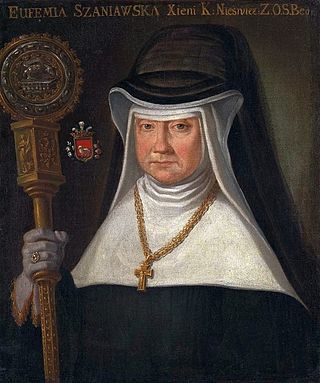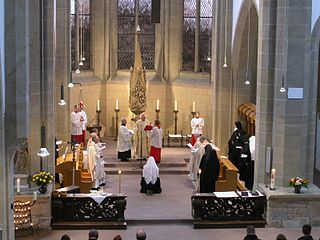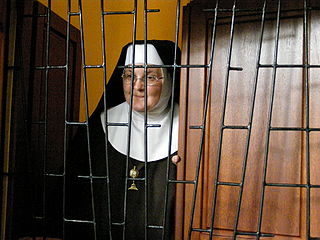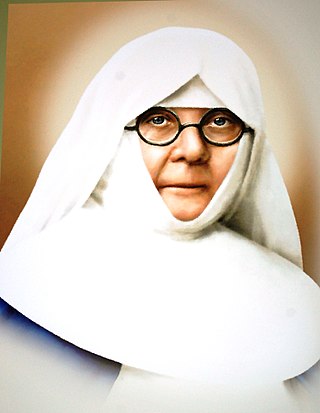
An abbess is the female superior of a community of nuns in an abbey.

A nun is a woman who vows to dedicate her life to religious service and contemplation, typically living under vows of poverty, chastity, and obedience in the enclosure of a monastery or convent. The term is often used interchangeably with religious sisters who do take simple vows but live an active vocation of prayer and charitable work.
A religious order is a lineage of communities and organizations of people who live in some way set apart from society in accordance with their specific religious devotion, usually characterized by the principles of its founder's religious practice. It is usually composed of laypeople and, in some orders, clergy. Such orders exist in many of the world's religions.

A monk is a man who is a member of a religious order and lives in a monastery. A monk usually lives his life in prayer and contemplation. The concept is ancient and can be seen in many religions and in philosophy.
In the Catholic Church, a religious profession is the solemn admission of men or women into consecrated life by means of the pronouncement of religious vows, typically the evangelical counsels.

Religious vows are the public vows made by the members of religious communities pertaining to their conduct, practices, and views.
A canoness is a member of a religious community of vowed women, historically a stable community dedicated to the celebration of the Liturgy of the Hours in a particular church. The name corresponds to a canon, the male equivalent, and both roles share a common historical origin. As with the canons, there are two types: canonesses regular, who follow the Rule of St Augustine, and secular canonesses, who follow no monastic rule of life.

Anglican religious orders are communities of men or women in the Anglican Communion who live under a common rule of life. The members of religious orders take vows which often include the traditional monastic vows of poverty, chastity and obedience, or the ancient vow of stability, or sometimes a modern interpretation of some or all of these vows. Members may be laity or clergy, but most commonly include a mixture of both. They lead a common life of work and prayer, sometimes on a single site, sometimes spread over multiple locations. Though many Anglicans are members of religious orders recognized by the Anglican Communion, others may be members of ecumenical Protestant or Old Catholic religious orders while maintaining their Anglican identity and parochial membership in Anglican churches.

Enclosed religious orders are religious orders whose members strictly separate themselves from the affairs of the external world. The term cloistered is synonymous with enclosed. In the Catholic Church, enclosure is regulated by the code of canon law, either the Latin code or the Oriental code, and also by the constitutions of the specific order. It is practised with a variety of customs according to the nature and charism of the community in question. This separation may involve physical barriers such as walls and grilles, with entry restricted for other people and certain areas exclusively permitted to the members of the convent. Outsiders may only temporarily enter this area under certain conditions. The intended purpose for such enclosure is to prevent distraction from prayer and the religious life and to keep an atmosphere of silence.

The Passionist nuns are an order in the Roman Catholic Church. The nuns were the second Passionist order to be established, founded in 1771 by Paul of the Cross and Mary Crucified. The Passionist nuns are a cloistered, contemplative community.
The conditions for the canonical erection of a house of religious are indicated in canons 608-611 of the 1983 Code of Canon Law.
This is a glossary of terms used within the Catholic Church. Some terms used in everyday English have a different meaning in the context of the Catholic faith, including brother, confession, confirmation, exemption, faithful, father, ordinary, religious, sister, venerable, and vow.
In the Catholic Church, a religious institute is "a society in which members, according to proper law, pronounce public vows, either perpetual or temporary which are to be renewed, however, when the period of time has elapsed, and lead a life of brothers or sisters in common."

Marcelina Darowska was a Polish religious sister who was beatified by Pope John Paul II in 1996. She was inspired to co-found the Sisters of the Immaculate Conception of the Blessed Virgin Mary, a congregation in Poland, Belarus and the Ukraine.

The Bernardine Cistercians of Esquermes are a small branch of the Cistercian Order. They follow the Rule of St Benedict, and co-operate with the apostolic mission of the Catholic Church through educational activities and hospitality. There are eight monasteries of nuns in six countries, united by a central Government.

Ana de Jesús, translated into English as Anne of Jesus, was a Spanish Discalced Carmelite nun and writer. She was a close companion of Teresa of Ávila, foundress of the Carmelite reform and served to establish new monasteries of the Order throughout Europe. Known as a mystic and for her writings on prayer, she has been declared Venerable by the Catholic Church.
In the canon law of the Catholic Church, a person is a subject of certain legal rights and obligations. Persons may be distinguished between physical and juridic persons. Juridic persons may be distinguished as collegial or non-collegial, and public or private juridical persons. The Holy See and the Catholic Church as such are not juridic persons since juridic persons are created by ecclesiastical law. Rather, they are moral persons by divine law.

María Concepción of the Nativity and the Perpetual Help of Mary is the religious name of the Reverend Mother Foundress of The Order of Atonement of the Franciscan Minims of the Perpetual Help of Mary (mfPS) which she founded on June 24, 1942, in Zamora, Michoacan, Mexico.

A religious sister in the Catholic Church is a woman who has taken public vows in a religious institute dedicated to apostolic works, as distinguished from a nun who lives a cloistered monastic life dedicated to prayer and labor, or a canoness regular, who provides a service to the world, either teaching or nursing, within the confines of the monastery. Nuns, religious sisters and canonesses all use the term "Sister" as a form of address.
The Daughters of Mary Immaculate are a Catholic religious institute of Religious Sisters co-founded in 1816 by Adèle de Batz de Trenquelléon and William Joseph Chaminade for the purpose of providing assistance to the poor. They are commonly known as the Marianist Sisters.













